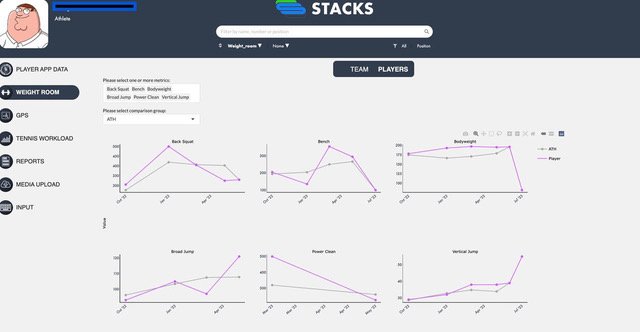Personal Sport Science: Oliver Wilson Showcases the Future of Individual Athlete Support
Check out our “High Performance Short” interview with BreakAway Ambassador, Oliver Wilson. He explains how he devised his own performance data system, how it helps him perform, and his ideas to find gains. 9 min listen.
The Individualisation Problem
Professional athletes in sports like Tennis, Golf, Football (American), Football and Basketball, can view data from many different sources. That data informs answers to performance challenges asked by athletes, coaches and trainers the world over, such as; “How can athletes best manage training load and recovery?” “How can they reduce injury risks?” “How much sport-specific skills practice is ideal?”
So when you turn to data and technology to enhance decision making, what do you need to do in order to get value above and beyond a ‘gut feel’? Those, like Oliver Wilson, strive to create a personalised combination of performance data that can drive a smarter, data-informed approach to preparation and performance.
10 years ago, accessing testing and data was the challenge. Now, the problem athletes face is how to choose a meaningful combination of tests and metrics, from the many options available. Selecting an appropriate set of metrics creates a data picture that, when considered along with the athlete’s personal context, helps find answers to questions such as, “Am I ok to train hard today?” Or, “How much loading should I aim for next week?” A data-informed approach gives a baseline, from which you can calibrate how the athlete feels and guide decision-making. As Daniel Kahnemann1 might advocate, it helps find more of the signal from the noise.
Oliver Wilson’s Solution
Two-time DP World Tour winner, Ryder Cup player, and BreakAway Athlete Ambassador, Wilson, faces the continual challenge of balancing the demands of travel, playing tournaments, practising golf, preparing physically and recovering with his family. To help himself he has customised his BreakAway App with a unique combination of daily readiness tests, subjective wellness scores and Whoop metrics. Specifically, he can see his Whoop overnight sleep and HRV numbers, along with his morning Grip Strength and ‘Ready to Go’ scores.
Wilson says “BreakAway means my team can see all the measures I am implementing in one place on a daily basis. This gives us a number we can make decisions from. It's not a hard and fast, Yes or No thing, but a basis for deciding how much training I need to do…I’ve just come off a 5 week block and we used the metrics to manage my load, so I avoided getting fatigued during the final weeks, finishing up with The Open Championship.
Individualised Workload, Readiness and Adaptation Data Connections
BreakAway connects an athlete's data from their devices and wearables to their mobile App, and their support team’s laptops. This creates a real-time performance data connection between the athlete and their team; with no additional portal logins, WhatsApp or emails required.
Other BreakAway athletes and their support teams use our STACKS software to connect, in real-time, a personalised combination of performance data to make data-informed decisions about their key performance questions. To answer ‘Readiness to train’ concerns, a smart approach we see is combining different objective and subjective measures to create a personalised readiness matrix, or benchmark. For example, Sleep Time + HRV automatically from a wearable device such as Oura, combined with physical tests such as 10 Hop contact times, and a self-report Leg Soreness rating.
Knowing both the current levels and on-going trends of an athlete's workload is also key. So the ability to automate porting of GPS or movement sensor tracking data (e.g. STATSports, Catapult, Kinexon) into the mix for team sport athletes from Football (Soccer) and Basketball is a huge advantage. This lines up their workload, alongside their personal recovery metrics, again helping their support teams drive a data-informed approach to their performance.
Finally, the continual collation of performance and assessment data, over the long term, informs how an athlete is adapting to their competition and training schedule. This approach provides the baseline profile, from which programming decisions can be made and training objectives set. Devices, such as VALD Force Decks, can automatically be ported, alongside direct inputs, and tracked longitudinally, with simple but effective visualisations.
Customisable Approach
BreakAway is founded and built upon high-performance expertise. We know that athletes, and their support teams, make decisions from combinations of data, factoring in their current performance and personal context. There is no-fixed formula to performance monitoring, and what is needed is the flexibility to combine data from different sources, allowing the athlete and their support to engage with data, naturally in sync with how they make decisions about their training and recovery. BreakAway allows data to be tailored to personal preferences, and aggregated to build a picture of athletes’ current workload, readiness and adaptation status.
< Andy Murray Embraces Athlete Data: Training Smarter is better than Training Harder >
The way forward
Individualisation is one of the key trends in high performance sport and technology needs to complement and enhance how elite performers and their support staff work. This will be true, not just for the Wilsons of this world, but across professional sports, as athletes need to find their own competitive edge to gain contracts, get selected, and achieve their winning ambitions.
1 - Kahneman, Sibony and Sunstein, 2021. Noise: A flaw in human judgement.


